SEO Best Practices for 2023: Boost Your Traffic
SEO is a powerful tool to make your product visible online. If you do it right, as a great bonus to website traffic, you get increased sales, high-quality leads, authority, and satisfied customers.
But there is a problem: Google is constantly tweaking its search algorithms. Recently, it released a global update about the ranking of helpful content. As a result, info websites saw a great change in positions. So there’s no guarantee that the methods of 2021-2022 will keep working in the future.
Wanna stay up to date? In this article, we’ve collected a list of the latest SEO best practices to grow your traffic in 2023:
- Keyword research
- Search snippets and how to use them
- FAQs, images, videos, code markup, etc.
- Internal and external backlinks
- Technical SEO
Let’s dive in.
Fast Tips to Improve Your Keyword Research
Choosing the right keywords is the key to attracting high-quality traffic and leads. So here are a few tactics I use.
- Know your buyer personas’ challenges, interests, and phrases they use to search for that info. It will help you find relevant keywords.
- Define your goals before keyword research. What is the final goal you want to achieve? If you want to grow your email list, choosing Top Of The Funnel topics like “What is” or “Why” is okay. But if you want sales, choose commercial intent keywords and the Bottom of the Funnel topics like “Top 10 tools” or “How to”.
- Some keywords have multiple meanings, like haberdashery for bowlers and hats. To ensure it meets your buyer persona, check the content of the top websites in SERP.
- Don’t choose options with high Keyword Difficulty if you have low traffic. It means competitors with an army of backlinks and thousands of traffic use them, so you will only see the top 20 if you spend some budget.
I’d love to be at the top of the “best chatbot” keyword results, but the KD is crazy. Even with my 10K traffic, it is too challenging. 43 KD looks much more realistic.
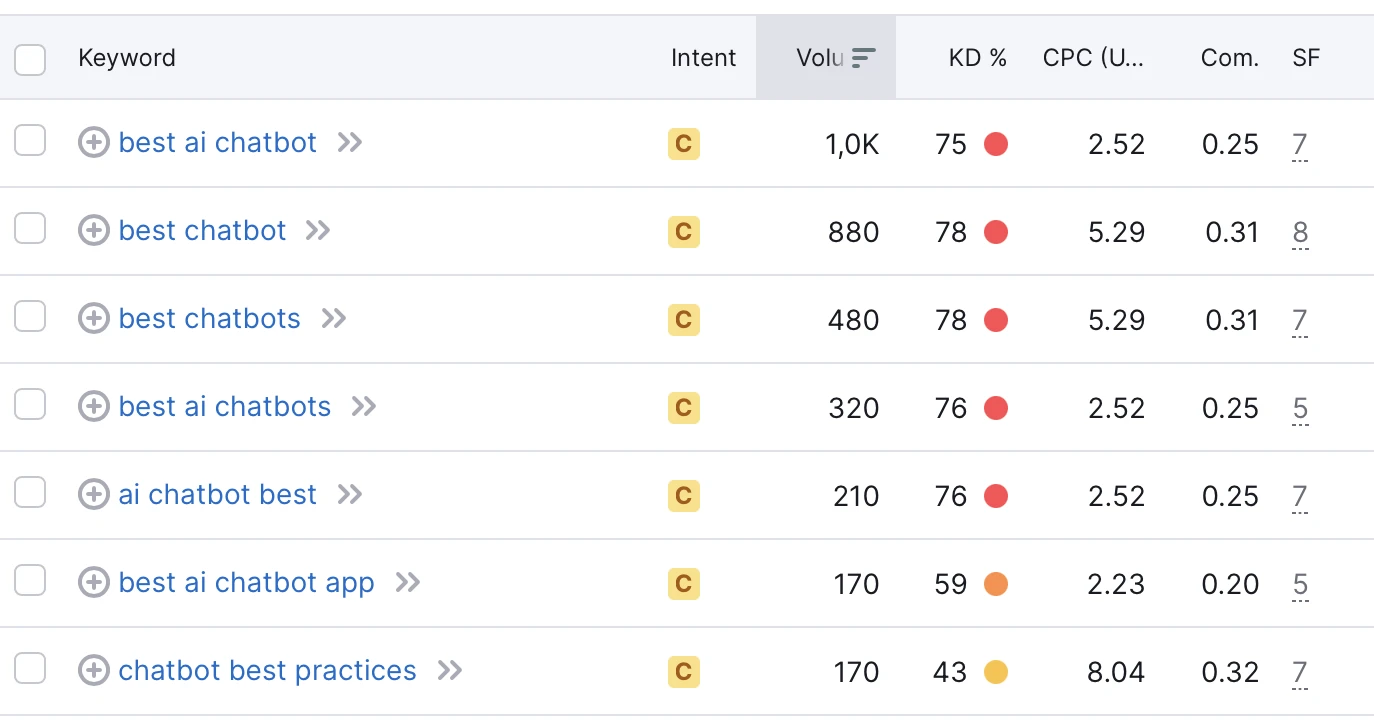
This keyword research is performed using Semrush. Grab Semrush free trial and win the SERPs.
And the main thing, regularly track your search ranking to define if there is some issue and fix it fast.
Structurize Your Content for Search Snippets
Snippets are the way you can hack your competitors’ positions. For example, the bankrate.com website isn’t the first in the SERP on the investments for beginners keyword. But still, they are there thanks to the Google snippet 👇
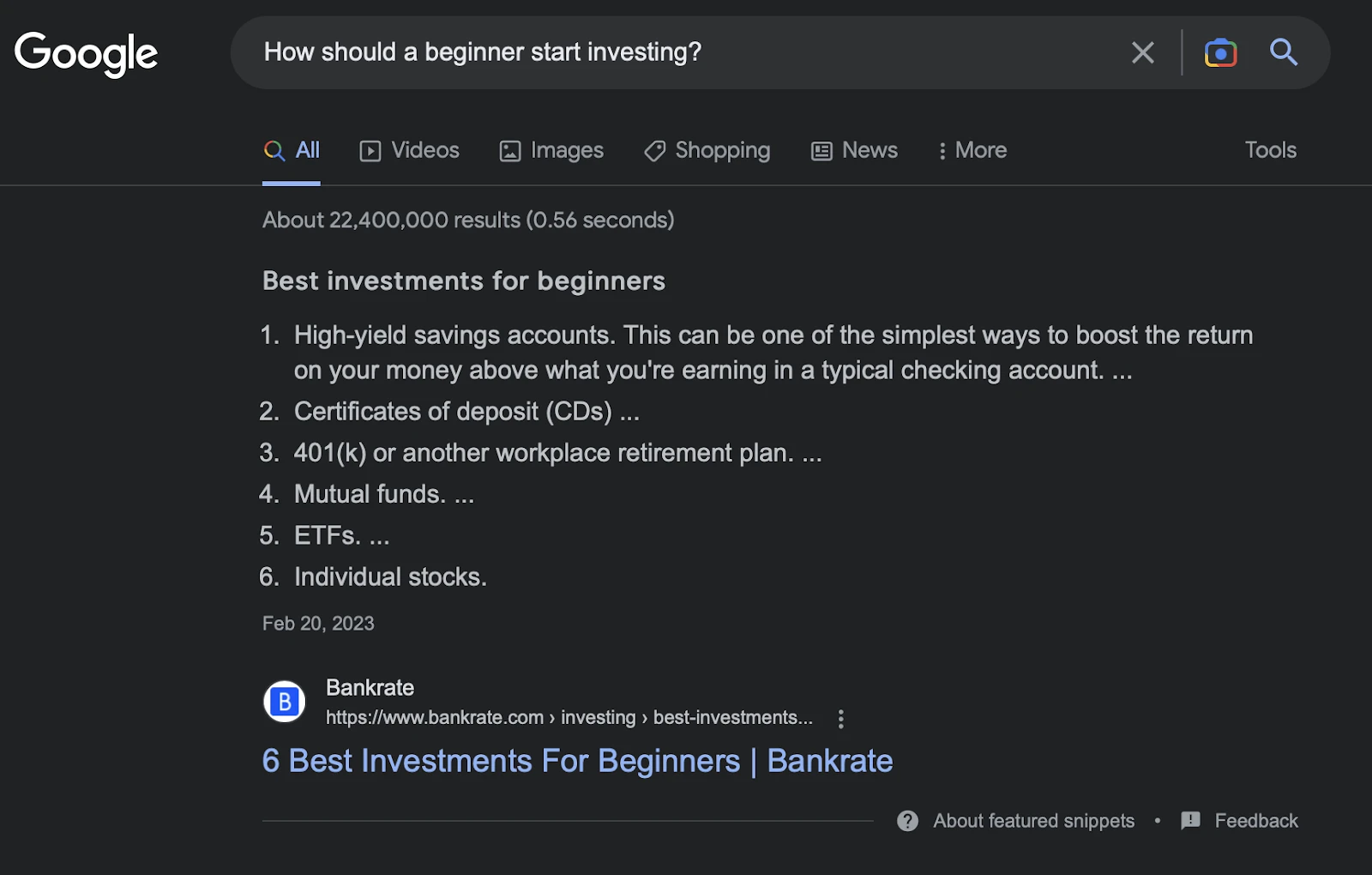
In addition, featured snippets account for 35.1 percent of total clicks! So how to achieve such a result?
Semrush did a great research on this topic. Here are its key takeaways to follow:
- For mid-size and long articles, use a clickable table of contents. For example, HelpCrunch recently published the 10 Types of Chatbot article. To ease blog readers’ navigation and get an extra clickable link inside target SERPs, we placed a table of contents at the beginning of the post:
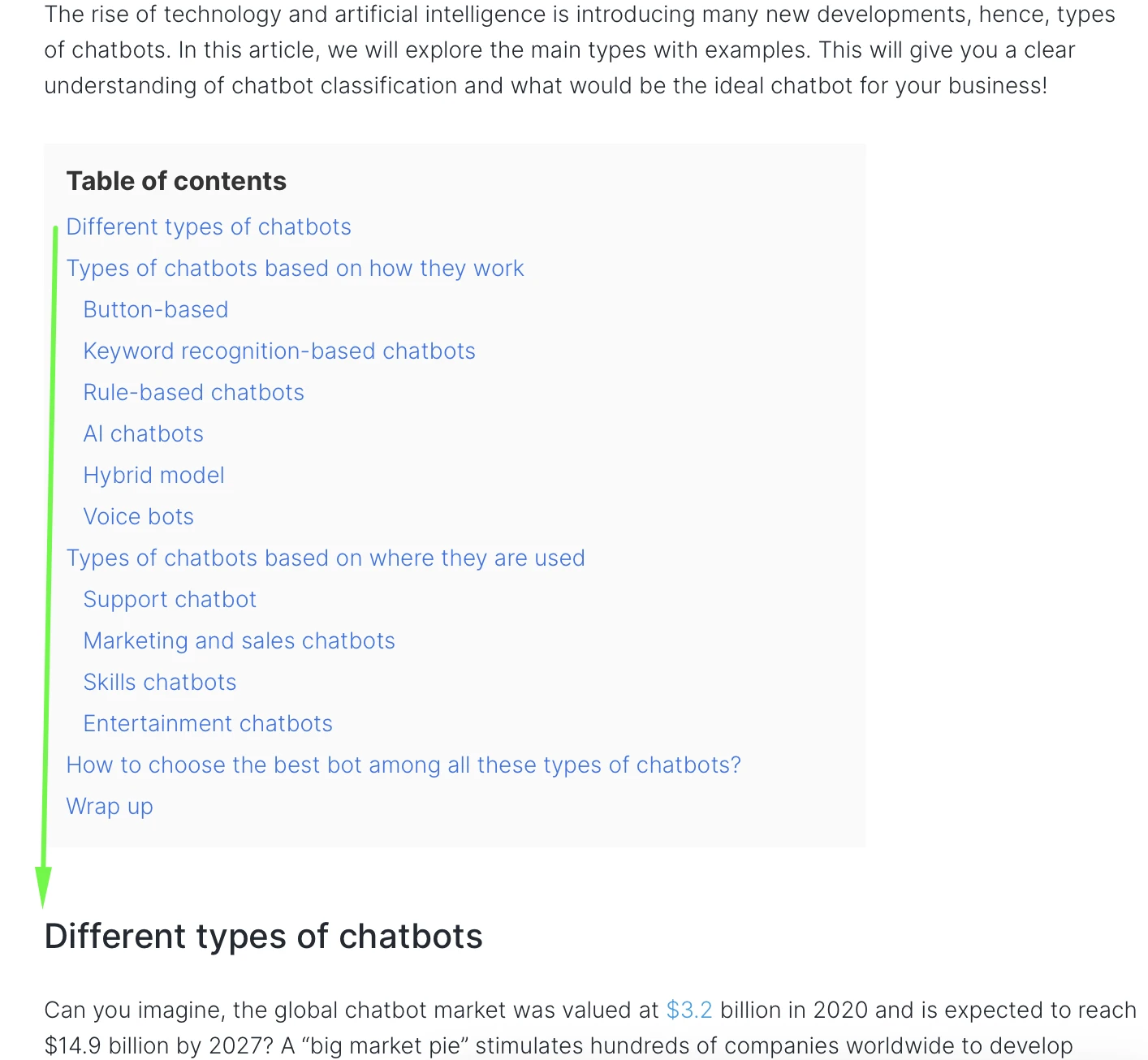
By clicking at any list item, readers will jump to a relevant part of the article. Image source.
- “What is …”, “Can,” “Do,” and “Why” subheadings have more chances to be featured in a snippet. Especially if you follow it with a short announcement about what you will tell further.
- Instead of a single-word keyword, choose long tale ones with 5-10 words.
- Google feels a very particular attachment to tables, lists, and videos. To get into featured snippets with this format of content, consider this data:
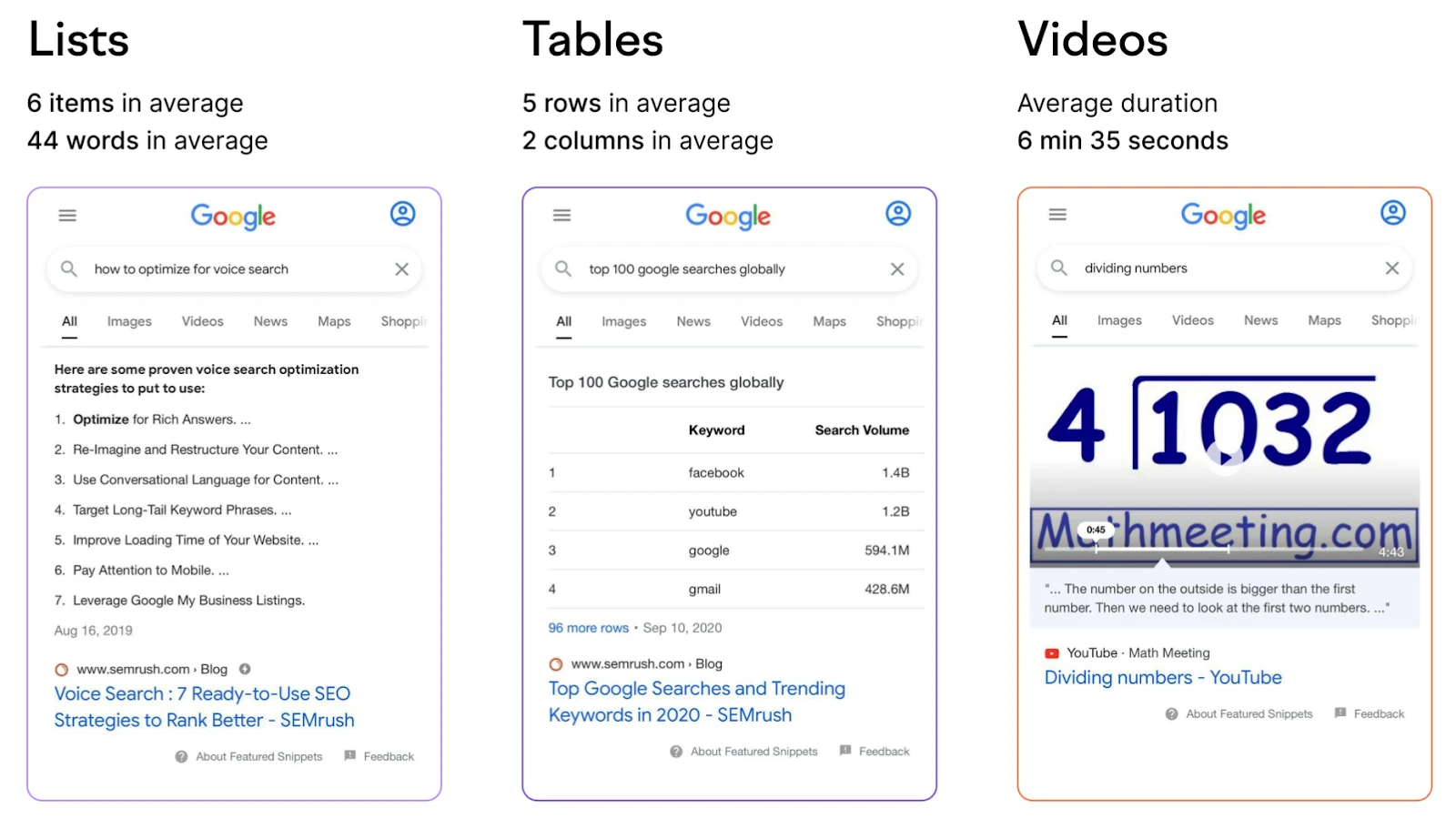
- Use images that have a 160 x 200px or 960 x 1200px ratio.
- At the end of the article, add an FAQ section. Check for questions people have on your topic in the “People also ask” section. Answer them with at most 50-60 words.
- Keep your URL under 1-3 subfolders.
- Make sure your publication has a date. Update your content each 2-3 years.
Text is one of many content types that can bring you traffic. Images and videos can be independent players in the SEO game. Just optimize them accordingly.
Optimize Your Images
Google images have great sales potential. This instrument works for all industries, but the best is for eCommerce. For instance, I want to find a stylish summer bag and use relevant keywords. In addition to the images, I can see links to the stores and an item “in stock” status.
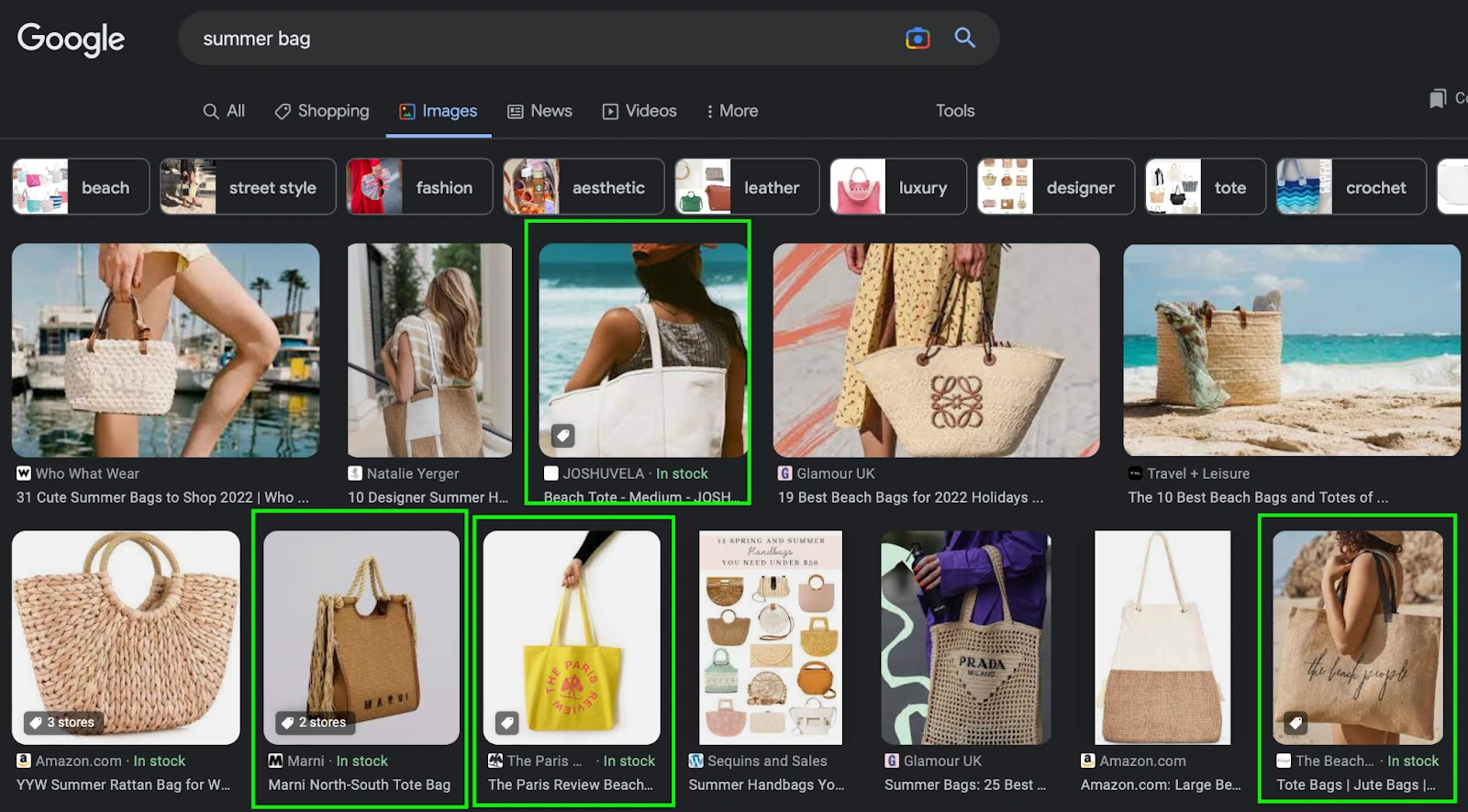
So here are some latest tips on how to get additional traffic with images:
- Use PNG for infographics and JPG for photos. Both are lightweight and have good quality. Another option is WebP. It provides excellent lossy compression and lossless resize for web images.
- The bigger your image size, the longer it takes to download your website. There are special plugins like ShortPixel that can compress them automatically.
- Add alternative text to your images with target keywords describing the primary context in 125 characters.
- Apply the lazy-load technique. Thus, a website doesn’t have to load them all the moment readers open the page. They will be loading on the way they scroll the content.
- Add keywords to the image file names.
Leverage the SEO Power of Videos
Videos on your website can bring traffic as well. There is an excellent section in the Google search like “Videos.”
It works the same as images: your potential customer looks for the video guide on the chatbot and sees a video with a link to your website.
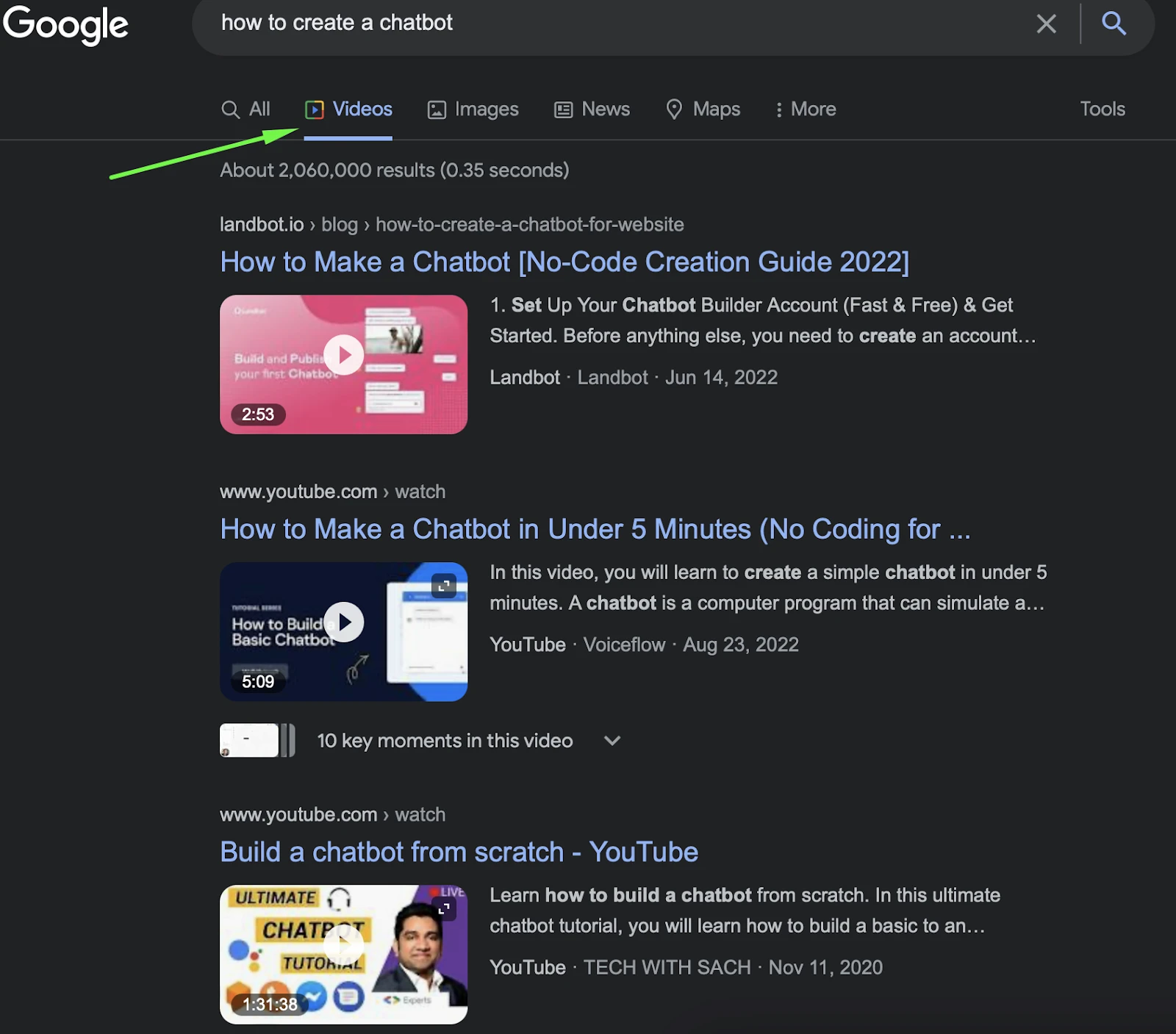
Want to get the first positions on this list? Follow these best practices:
- Replace your animations with videos because the last one is better for website load speed.
- Tag your video title with relevant keywords. Use the same for the text of your eye-catching thumbnails.
- Add a clear description to your video with several CTAs and links to your website. Google bots will crawl it to ensure the video’s content and title meet the consumers’ expectations.
- Unless it is music without words, a video transcript is a must. Google crawls it as well.
- If there are several videos on your page, place first the one you want to get ranked.
- Make sure the rest of the web page content is relevant to the video.
- Follow the “one video — one page” rule. Publishing the same video on different pages is competing against yourself.
Ensure You Have Internal and External Backlinks
The easiest link type here is internal because it is the process you control. So these are links on a page of your website to the content of its other pages. In addition to the visitors’ navigation, they serve an excellent SEO goal — send page authority to essential pages and help to achieve higher rankings in Google.
Here are a few tips to improve your internal backlinks strategy.
- Define the list of pages you are going to link to. All of them should be strategically important because: 1st — you send authority to that page and help it rank better; 2nd — you offer visitors to leave the current page, so make sure that it can convert them.
- Use keywords in your anchors. But ensure they have a relevant context, as my team did on the HelpCrunch blog. Here is an example of the internal link to our main page👇

All the text around it is about chatbots as well. Image source.
- Make all of your anchor text different. Let’s say you have an AI chatbot page and a rule-based chatbot. Linking to both with a “chatbot” anchor would confuse Google because you basically say, “these two pages are the same”.
- Add links in the first part of your content. People click links in the first part of your content. So place it there, and people will spend more time on your website.
- Avoid internal link automation because it leads to irrelevant anchors and strategic chaos.
- Regularly conduct a site audit to check for broken links on your pages and other tech issues.
There are also outbound (external) links from your website to third-party sources. The primary rule here is to link to the trustworthy domains that ideally have the same or bigger Authority Score (AS) than your website (at least 30). Lower AS links can hurt your ranking.
Inbound links are the most difficult because it is about other websites’ decision to link back to your page content. In such a way, they prove to Google that your website content is relevant and high-quality.
The more external links you have, the better your website positions. And here are several ways to get them:
- Create high-quality content on your website (researches, stats, infographics, unique images, etc.), so other sources want to use it and link back to you.
- Pitch your content as a guest post to the chosen websites.
- Offer to exchange links without any additional content to publish.
But the main secret is to choose the right website, anchor, and place in the text.
- Here works the same rule as with internal links. Anchor should be unique, include a keyword, and has relevant context.
- To make your link more eye-catching, ensure there are no other links in the paragraph. Moreover, too many external links on one page can look like link networks or spam, hurting your SEO efforts.
- Check if they do follow and open in a new tab.
- Ask to publish it in the first part of the content.
- Don’t collaborate with low-quality websites and bother about website safety: Authority Score is lower than 30 or yours, poor website traffic, irrelevant content with too many links.
Check if Your Website Meets the Latest Tech SEO Requirements
Working on content structure and keywords increase your website’s chances of getting better positions. But if you want it to be entirely optimized, take care of the tech part.
Here is a list of best practices to follow:
- Make sure there is only one version of your website available: “www” or “non-www.” If there are two of them, choose one and redirect the second.
- Check if your page load speed is 2.5 seconds or less.
- Google evaluates the way you protect visitors’ data: the HTTPS element in the website URL means it is safe.
- Mobile-friendly websites rank better. Ensure that people who visit your web pages from mobile have the same great experience as desktop users.
- Fix broken links and pages.
There is only a part of SEO requirements to the tech part of your website performance. If you wanna check the rest, follow this checklist. It contains free, easily accessible tools and resources.
To Sum Up
You can easily get lost in the variety of SEO methods on the market. But not all of them can meet your company goals. Recently, I had a great strategic change in SEO: we shifted from long-term SEO to achieve fast results. That means no high-level and over 50 KD keywords. Instead, we choose only topics that can bring us to the top 5 SERPs in 2 months maximum.
That’s why defining your product strategy, goals, and buyer persona challenges you to reach out first. Only then choose criteria for your keyword research and other SEO activities.
